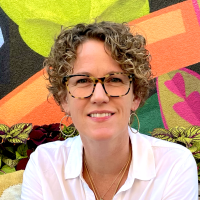
Is there any place more fraught with energetic landmines than the DMV?
Yesterday was a half-day at school. My daughter turned 16 seven days ago. I was out of technical reasons for saying we couldn’t go.
I felt the woman’s energy before I saw her. Imagine someone struggling to carry an overloaded laundry basket of squirming, grubby, grumbling gremlins up a flight of steep, narrow stairs. Hard for her; hard for us to witness. I say “us” because I could also feel other people’s discomfort with her as well as my own. As she became increasingly impatient and started to share her thoughts out loud, I could feel people trying to be polite enough to not downright ignore her but also desperately trying not to actually engage.
As the hour passed and I heard about every single injustice she had faced over the course of the day as well as the injustices of life in general, I found my usually well-grounded sense of compassion ebbing. Her life was absolute sh*t, but of course, absolutely none of it was her fault. Intellectually, I knew that if this was her general approach to life, it was no wonder she was having such a hard time with it. But energetically, viscerally, I felt my compassion curdling to contempt. And the force of old, deep, addictive habits took over. I finally gave in and fully scratched my itch: I judged her, and it felt good.
She possessed none of our culture’s attributes of traditional beauty. She was not young, slender, tall, well-dressed, well-groomed, clear-skinned, wrinkle-free. When she couldn’t get anyone’s attention with her fidgeting and sighing, she started her under-her-breath commentary. Her job was mundane, trivial, boring, and overrun with false urgency. She knew one of her vindictive coworkers would be sure to tell her boss that she was more than an hour late getting back from lunch. When she didn’t get attention with that, she started speaking directly to people who clearly didn’t want to engage. It was the intense neediness, indignation, and victimhood that ignited my contempt.
When she finally walked out after her number had been called and served, she had been transformed into a spectacular martyr. She practically sashayed down the aisle between the rest of us poor suckers while she prepared (out loud) her tale of bloody victory at the DMV for her next audience. By the time she left, the combination of her “wrongness” and my fully-indulged righteousness was practically orgasmic—it felt so good I scratched until it bled.
The invisible wounds
There was a time in my journey when I would have spent a fair bit of time beating myself up in the wake of yesterday’s emotional/energetic behavior. It would have been proof that I was not a good person. I would have slapped on a whole new layer of self-judgment about being judgmental. What I’ve come to understand, however, is that judgment is the key to finding all the invisible wounds. The woman in the DMV was a gift.
Of all the modalities I have investigated, the most profound tool I have almost mastered is one of the simplest—cultivating an awareness of my judgment. It acts as a blinking neon sign pointing to my invisible wounds—the kind that cause me to feel, be, and act from places of pain, fear, insecurity, and shame. The judgment we cast toward others mirrors the self-inflicted, often informed-by-others judgment we put upon ourselves. Awareness of this double-sided judgment is a potent portal of transformation that is often deeply uncomfortable, annoyingly simple to practice (=no excuse), and extremely effective.
Excavating my DMV judgment palooza later, especially as I had allowed myself to really indulge in it, I unpacked some tender, wounded things in myself that I had not acknowledged before. At a certain level, I had the same contempt for myself as I had for the woman I had used my judgmental flamethrower on. I will leave the gory details for another article as the real point is that the relief and healing I felt were in proportion to the scope of the judgment and my willingness to engage with it.
Once excavated, replaying the DMV scene, relieved of my invisible wounds, was like watching a familiar story with a new soundtrack. It was a completely different experience. Not only did I find relief for myself, but in re-experiencing the unhappy woman through a new lens, I also upgraded my capacity to maintain my compassion in future, similar circumstances.
How to practice judgment awareness
As I mentioned earlier, this is not rocket science. But I do recommend practicing this with strangers first, as it creates a clearer playing field than, say, trying to figure out your relationship with your mother. (You can also do this with things and places. I have figured out much about my relationship with money this way.)
1. Identify the Moment: When you experience a “Moment of Ew” about someone or something, make a note of it. Jotting it down is recommended to capture all details.
2. Revisit the Moment: Later, in a quiet space, revisit the moment and identify specific details that triggered your reaction, such as someone’s clothing style or how they spoke to someone. It really doesn’t matter what these are, you just need something to hook you back into the memory of the experience.
3. List Irritations: Create an itemized list of everything you found irritating or unacceptable about the person or situation. Don’t forget to consider the environment and the overall energy of the moment as they provide context. Allow yourself to fully express your feelings until you feel capital-S satisfied.
4. Analyze the List: Review your list and identify the item that causes the loudest, most uncomfortable buzz for you.
5. Question Your Reaction: Ask yourself why this particular thing bothers you so much. (Clue: It bothers you because it makes you feel something you’d prefer not to feel.) Continue questioning each subsequent answer to dig deeper into your feelings. Use questions like “So what?” to further explore your emotions. Try to avoid steering yourself toward the “right” answers.
Keep drilling down on the original question until you find the core of it. You’ll feel and know it when you get there. It will release a bubble of awareness—light and air where there was previously pain, fear, or shame hidden in the darkness. Sometimes the flickers of awareness are as small and light as champagne bubbles. Other times, the shifts can be unexpectedly seismic. It is completely up to you whether you repeat steps four and five for other items you excavated during the experience. Don’t pull a hammy your first time out!
As I mentioned earlier, it is an almost painfully simple practice, but with sustained intention and investigation, it becomes a powerful tool for healing and transformation. It is not a practice that will make us perfect, but it is a practice that can offer profound insight into our deepest selves while fostering greater empathy for others—a journey worth undertaking on behalf of all of us.
~

This account does not have permission to comment on Elephant Journal.
Contact support with questions.